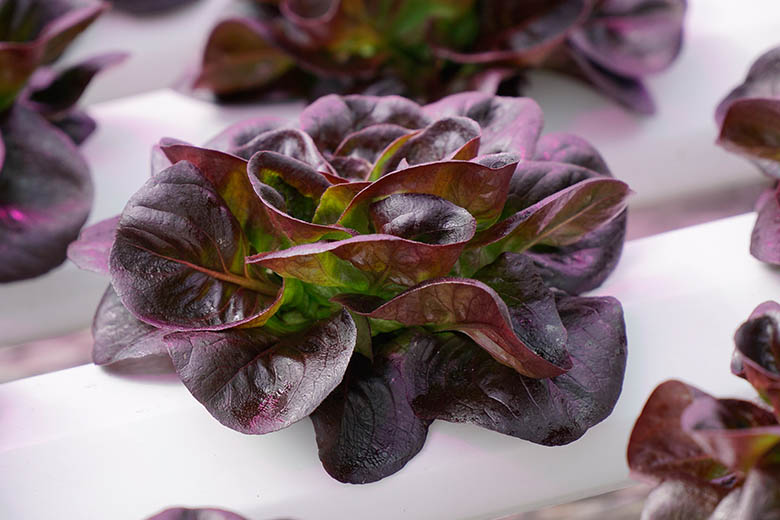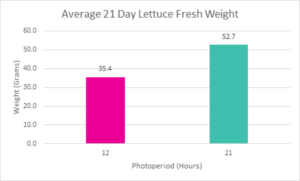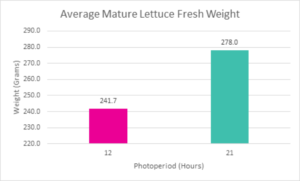
Use a High Yield Photoperiod to Increase Lettuce Production by 40 Percent
{Sponsored} Daily Light Integral (DLI) is a commonly used metric to describe the amount of light a plant receives in a day. It is well-established that an increase in DLI generally correlates with an increase in crop growth, quality, and yield. LumiGrow Research investigated the effects of differing day lengths and intensities with equal DLI to better understand how to use supplemental lighting efficiently for growing leafy green crops.
LumiGrow Research found that extending the photoperiod while maintaining the same DLI increased the harvestable biomass of baby lettuce by over 40 percent, and of mature lettuce by 15 percent in a greenhouse production environment. The breakthrough discovery by LumiGrow Research is now being termed as a “High Yield Photoperiod.”
High Yield Photoperiod lighting strategies dramatically boost crop yields by utilizing the same amount of energy that your lighting system is already using and delivering this light more appropriately over a longer period of time throughout the day.
The process of maintaining a consistent DLI over a longer photoperiod has only recently become commercially feasible with the technological advancement of the world’s first integrated horticultural light sensor.
The LumiGrow Light Sensor works with the LumiGrow smartPAR™ software platform by taking in solar data and using predictive analytics to automatically adjust LumiGrow fixtures. This makes it possible to achieve a specific DLI and photoperiod in a precise and consistent manner.
In past studies, LumiGrow Research found that peppers and tomato seedlings grown under longer photoperiods with a similar DLI produce more overall growth. This research demonstrates the profound potential for achieving a High Yield Photoperiod for many types of crops.
Methodology
Table 1
| Species | Varieties | Number | Technology | Grow Space | Starting Materials and Conditions |
| Lettuce | Skyphos | 500 | Nutrient Film Technique (NFT) | 6 ft. benches | Seed |
Skyphos lettuce was grown under LumiGrow Pro 325 fixtures in a double-poly hoop house production environment at Cabrillo College in Aptos, California. Seedlings were germinated and grown in a propagation area until first true leaves formed, then placed into treatments. Plants were grown for approximately four weeks under treatment conditions before destructive measurements were taken. Fresh mass and dry mass measurements were taken. Two replicates were conducted, reversing the placement of the two lighting conditions in the greenhouse.
Table 2
| Lighting Conditions | Lighting Sources | Lighting Type | Photoperiod (hours) | Total Daily Light Integral (molˑm-2ˑday-1) |
Supplemental Daily Light Integral (molˑm-2ˑday-1) |
| Solar and Supplemental | LumiGrow Pro 325 | LED | 12 | 17 | 7 |
| Solar and Supplemental | LumiGrow Pro 325 | LED | 21 | 17 | 7 |
Results
Lettuce Biomass Comparison: The combined data from both replicates  demonstrated a fresh biomass increase of over 40 percent in baby lettuce, and a 15 percent increase in mature lettuce after a full production cycle is possible with longer photoperiods while maintaining a consistent DLI.
demonstrated a fresh biomass increase of over 40 percent in baby lettuce, and a 15 percent increase in mature lettuce after a full production cycle is possible with longer photoperiods while maintaining a consistent DLI.
The data for respective conditions was similar between replicates. Additionally, both replicates demonstrated a dry weight increase that correlated with the increase in fresh biomass. This demonstrates that the increase in fresh weight was due to increased production of leaf tissue.

Tip Burn Comparison: Skyphos in the 12-hour photoperiod exhibited greater tip burn in comparison to the 21-Hour treatment.
This suggests photoperiod may allow for management of controlled environment production issues.
Conclusion
Smart LED lighting can be used to consistently achieve a higher DLI and longer photoperiod than solar light alone in the greenhouse. When maintaining a DLI of 17 mol·m-2·day-1, overall increases in fresh weight biomass under 21-Hour treatments compared to 12-Hour treatments can exceed 40 percent in baby lettuce and 15 percent in mature heads of lettuce. This methodology uses the same overall power usage to drive increased productivity.
Download the research paper today by clicking here
The authors of the study are Jake Holley and Brian Poel and Melanie Yelton, LumiGrow, Inc., Emeryville, California; and Sarah Hulick and Peter Shaw, Cabrillo College, Aptos, California.


 Video Library
Video Library 




















